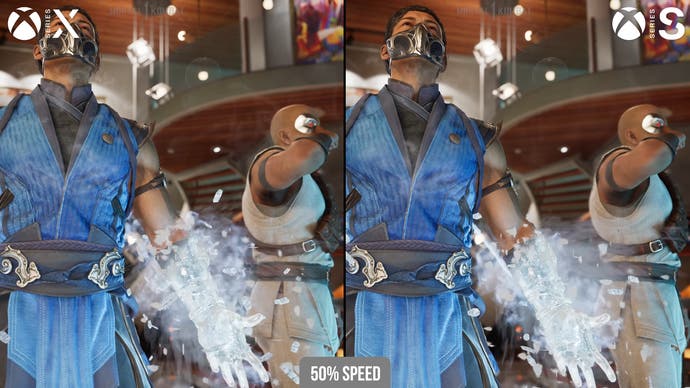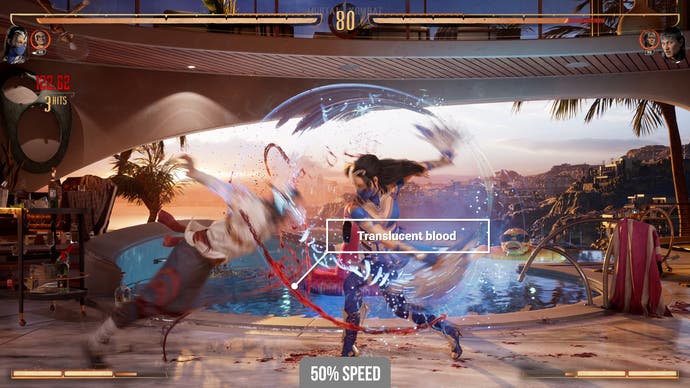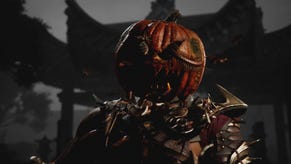Mortal Kombat 1's network test shows promise on Xbox Series X and Series S
The two Xbox versions tested ahead of the game's launch.
With only a few months between its announcement and 19th September release date, Mortal Kombat 1 feels like a masterclass in how to reveal a new game. This past weekend only reinforced that fact with the release of the game's first network stress test, giving gamers around the world the chance to try out the latest in Mortal Kombat. I joined the test on Series X and Series S and have some thoughts on how MK1 is shaping up, from early resolution and performance numbers to more subjective impressions of the graphics and technology that power the game.
What makes this release particularly interesting is developer NetherRealm's decision to move to Unreal Engine 4 - rather than sticking with their own UE3-derived tech or jumping to the more advanced Unreal Engine 5.
When you first boot the game, you're greeted by a gorgeous native 4K background with crisp menu elements, with two modes (an offline four fight ladder and an online mode) and seven characters available for the stress test. Sub-Zero, Liu Kang, Kenshi and Kitana are the four main options, with three Kameo characters: Kano, Sonya Blade and the cigar chomping Jax.
Mortal Kombat 1 treats you to one of the finest transitions from selection screen to fight that I've seen. It starts the second you find a match - the two default fighters emerge from the treeline and the selection window appears seamlessly. You choose your fighter and Kameo, then marvel as the two competitors assume MK3-like poses. With the camera zoomed in, the background is out of focus, but you'll notice it change based on the stage you're currently highlighting. Once you hit that button, the two fighters exchange words and the camera pulls out to reveal the fighters in the selected stage.
There are no cuts here - it's just a straight line from menu to battle. Nailing that transition between menu and battle is key when it comes to building energy for the battle to come, and it's clear that engineering for SSD-equipped consoles has made a huge difference.
Once in the game, it's clear that Mortal Kombat 1 looks a lot better in motion than the low-bitrate YouTube trailer suggested. On Series X, the game aims to deliver a full native 4K, though dynamic resolution is in play with pixel counts coming in slightly below 2160p depending on the action. On Series S, 1440p is common during cinematic sequences but drops to around 1080p are typical during battle - although at least graphical settings look identical between the two platforms.

While the game is undoubtedly brighter and more colourful than MK11, the characters are of exceptionally high quality with expressive faces, realistic-looking skin and outfits with plenty of texture detail.
Once things kick off, the game's cloth and blood fluid simulation also impress, with the virtual cloth exhibiting realistic flexibility as it's effected by the movement of the fighters and gravity itself, while the blood system presents long, fluid trails of digital droplets with each attack.
In terms of animation, this game still feels very true to the style of Mortal Kombat, with the per-pixel character motion blur we saw in MK11. It's subtle, so it doesn't blur the action, but it does look great. The backgrounds are also shaping up to be impressive, with well-crafted materials, subtle shadowing and proper reflections, backed up with realistic physics that let you knock over smaller items. There's a ton of small detail throughout that really elevates the overall presentation.

Of course, the overall feel of a fighting game is often down to its performance. On Series X and Series S, we're looking at a solid 60fps, albeit with pre-match cinematics, Fatal Blows and Fatalities at 30fps. I know these scenes are more demanding, but it's a shame that we don't experience these moments at full frame-rate - something that is possible with the PC version of Mortal Kombat 11. Still, thanks to the excellent motion blur, those scenes look great.
In its current state, both Xbox versions of the game look and run very well and it's shaping up to be one of the best looking fighting games on the market. I did notice occasional internet-related hiccups while playing online, though, but these are minor and mostly relegated to pre-match sequences. It'll be fascinating to see the final version on the Xbox consoles, PC and PS5, but I expect good things.
The big question mark for me is the Switch version - MK11 sees a gigantic loss in visual quality but still plays well, but given that UE4 has wider support for Switch, perhaps MK1 will look slightly better? I guess we'll find out soon enough.









.png?width=291&height=164&fit=crop&quality=80&format=jpg&auto=webp)






